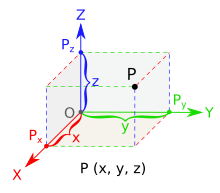
Back Driedimensioneel Afrikaans 3D ALS فضاء ثلاثي الأبعاد Arabic ত্ৰিমাত্ৰিক ক্ষেত্ৰ Assamese Tridimensional AST Üçölçülü fəza Azerbaijani اوچاؤلچولو مکان AZB Өс үлсәмле арауыҡ Bashkir Тримерно пространство Bulgarian तीन-आयामी स्पेस (गणित) Bihari
This article includes a list of general references, but it lacks sufficient corresponding inline citations. (April 2016) |

In geometry, a three-dimensional space (3D space, 3-space or, rarely, tri-dimensional space) is a mathematical space in which three values (coordinates) are required to determine the position of a point. Most commonly, it is the three-dimensional Euclidean space, that is, the Euclidean space of dimension three, which models physical space. More general three-dimensional spaces are called 3-manifolds. The term may also refer colloquially to a subset of space, a three-dimensional region (or 3D domain),[1] a solid figure.
Technically, a tuple of n numbers can be understood as the Cartesian coordinates of a location in a n-dimensional Euclidean space. The set of these n-tuples is commonly denoted and can be identified to the pair formed by a n-dimensional Euclidean space and a Cartesian coordinate system. When n = 3, this space is called the three-dimensional Euclidean space (or simply "Euclidean space" when the context is clear).[2] In classical physics, it serves as a model of the physical universe, in which all known matter exists. When relativity theory is considered, it can be considered a local subspace of space-time.[3] While this space remains the most compelling and useful way to model the world as it is experienced,[4] it is only one example of a 3-manifold. In this classical example, when the three values refer to measurements in different directions (coordinates), any three directions can be chosen, provided that these directions do not lie in the same plane. Furthermore, if these directions are pairwise perpendicular, the three values are often labeled by the terms width/breadth, height/depth, and length.
- ^ Cite error: The named reference
IEV-i241was invoked but never defined (see the help page). - ^ "Euclidean space - Encyclopedia of Mathematics". encyclopediaofmath.org. Retrieved 2020-08-12.
- ^ "Details for IEV number 113-01-02: "space"". International Electrotechnical Vocabulary (in Japanese). Retrieved 2023-11-07.
- ^ "Euclidean space | geometry". Encyclopedia Britannica. Retrieved 2020-08-12.
